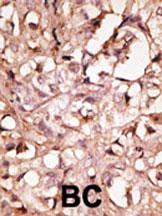XLKD1 Antibody (N-term)
Purified Rabbit Polyclonal Antibody (Pab)
- 产品详情
- 实验流程
- 背景知识
Application
| WB, IHC-P, E |
|---|---|
| Primary Accession | Q9Y5Y7 |
| Other Accession | NP_006682 |
| Reactivity | Human, Mouse |
| Host | Rabbit |
| Clonality | Polyclonal |
| Isotype | Rabbit IgG |
| Calculated MW | 35213 Da |
| Antigen Region | 46-77 aa |
| Gene ID | 10894 |
|---|---|
| Other Names | Lymphatic vessel endothelial hyaluronic acid receptor 1, LYVE-1, Cell surface retention sequence-binding protein 1, CRSBP-1, Extracellular link domain-containing protein 1, Hyaluronic acid receptor, LYVE1, CRSBP1, HAR, XLKD1 |
| Target/Specificity | This XLKD1 antibody is generated from rabbits immunized with a KLH conjugated synthetic peptide between 46-77 amino acids from the N-terminal region of human XLKD1. |
| Dilution | WB~~1:1000 IHC-P~~1:100~500 E~~Use at an assay dependent concentration. |
| Format | Purified polyclonal antibody supplied in PBS with 0.09% (W/V) sodium azide. This antibody is prepared by Saturated Ammonium Sulfate (SAS) precipitation followed by dialysis against PBS. |
| Storage | Maintain refrigerated at 2-8°C for up to 2 weeks. For long term storage store at -20°C in small aliquots to prevent freeze-thaw cycles. |
| Precautions | XLKD1 Antibody (N-term) is for research use only and not for use in diagnostic or therapeutic procedures. |
| Name | LYVE1 |
|---|---|
| Synonyms | CRSBP1, HAR, XLKD1 |
| Function | Ligand-specific transporter trafficking between intracellular organelles (TGN) and the plasma membrane. Plays a role in autocrine regulation of cell growth mediated by growth regulators containing cell surface retention sequence binding (CRS). May act as a hyaluronan (HA) transporter, either mediating its uptake for catabolism within lymphatic endothelial cells themselves, or its transport into the lumen of afferent lymphatic vessels for subsequent re-uptake and degradation in lymph nodes (PubMed:10037799). Binds to pericelluar hyaluronan matrices deposited on the surface of leukocytes and facilitates cell adhesion and migration through lymphatic endothelium (PubMed:26823460). |
| Cellular Location | Cell membrane; Single-pass type I membrane protein. Note=Localized to the plasma membrane and in vesicles near extranuclear membranes which may represent trans- Golgi network (TGN) and endosomes/prelysosomeal compartments. Undergoes ligand-dependent internalization and recycling at the cell surface Localizes at cell-cell junctions |
| Tissue Location | Mainly expressed in endothelial cells lining lymphatic vessels. |
For Research Use Only. Not For Use In Diagnostic Procedures.
Provided below are standard protocols that you may find useful for product applications.
BACKGROUND
One of the key groups of molecules regulating leukocyte and tumour cell migration is the glycosaminoglycan hyaluronan (HA). In inflammation, the exit of leukocytes across vascular endothelium to the underlying tissues involves interactions with cell surface lectin-like receptors on the leukocytes that bind HA on the lumenal surface of the endothelium. During normal tissue homeostasis and after tissue injury, HA is mobilized from these sites through lymphatic vessels to the lymph nodes where it is degraded before entering the circulation for rapid uptake by the liver. Lymphatic vessel endothelial hyaluronan receptor (LYVE)-1 is a major receptor for HA on the lymph vessel wall. LYVE-1 is expressed primarily on lymphatic vessel endothelium and is likely to be involved in regulating the traffic of leucocytes and tumour cells to lymph nodes.
REFERENCES
Jackson, D.G., Trends Cardiovasc. Med. 13(1):1-7 (2003).
Cursiefen, C., et al., Invest. Ophthalmol. Vis. Sci. 43(7):2127-2135 (2002).
Cunnick, G.H., et al., Biochem. Biophys. Res. Commun. 288(4):1043-1046 (2001).
Mouta Carreira, C., et al., Cancer Res. 61(22):8079-8084 (2001).
Banerji, S., et al., J. Cell Biol. 144(4):789-801 (1999).
终于等到您。ABCEPTA(百远生物)抗体产品。
点击下方“我要评价 ”按钮提交您的反馈信息,您的反馈和评价是我们最宝贵的财富之一,
我们将在1-3个工作日内处理您的反馈信息。
如有疑问,联系:0512-88856768 tech-china@abcepta.com.























 癌症的基本特征包括细胞增殖、血管生成、迁移、凋亡逃避机制和细胞永生等。找到癌症发生过程中这些通路的关键标记物和对应的抗体用于检测至关重要。
癌症的基本特征包括细胞增殖、血管生成、迁移、凋亡逃避机制和细胞永生等。找到癌症发生过程中这些通路的关键标记物和对应的抗体用于检测至关重要。 为您推荐一个泛素化位点预测神器——泛素化分析工具,可以为您的蛋白的泛素化位点作出预测和评分。
为您推荐一个泛素化位点预测神器——泛素化分析工具,可以为您的蛋白的泛素化位点作出预测和评分。 细胞自噬受体图形绘图工具为你的蛋白的细胞受体结合位点作出预测和评分,识别结合到自噬通路中的蛋白是非常重要的,便于让我们理解自噬在正常生理、病理过程中的作用,如发育、细胞分化、神经退化性疾病、压力条件下、感染和癌症。
细胞自噬受体图形绘图工具为你的蛋白的细胞受体结合位点作出预测和评分,识别结合到自噬通路中的蛋白是非常重要的,便于让我们理解自噬在正常生理、病理过程中的作用,如发育、细胞分化、神经退化性疾病、压力条件下、感染和癌症。









